#The Fourier Series
Video
youtube
The Fourier Series (demo) for the ZX81
0 notes
Text
"I have never seen Mr Fires be jovial in my life" <- person who only ever interacts with Fires to piss it off
20 notes
·
View notes
Text
everyone wish me luck on my differential calculus exammmm 😭😭
9 notes
·
View notes
Text
i was wondering if you could make a fourier series diverge at all the irrationals and converge at the rationals and came up with this monster

god i love and hate maths
6 notes
·
View notes
Text
you know, every semester there's at least one moment where I start breaking under the stress a little bit
kind of telling that I think this is the third one so far
#chattering#sorry for all the negative posts recently just. life hard#I'm like this close to having a breakdown over fourier series#this isn't even the first time I've seen them! I know how to do this the normal way just not the stupid complex exponentials way!#I have so much other shit to do I don't have time to be struggling with this#I'm like... not sure how I'm going to fit it all in
2 notes
·
View notes
Photo

Joseph Fourier was born on March 21, 1768. A French mathematician and physicist born in Auxerre and best known for initiating the investigation of Fourier series, which eventually developed into Fourier analysis and harmonic analysis, and their applications to problems of heat transfer and vibrations. The Fourier transform and Fourier’s law of conduction are also named in his honor. Fourier is also generally credited with the discovery of the greenhouse effect.
#joseph fourier#mathematics#physics#fourier series#fourier analysis#fourier transform#fourier's laws of conduction#greenhouse effect#science#science history#science birthdays#on this day#on this day in science history
3 notes
·
View notes
Note
tell me more about math in music theory?
it's all ratios an octave has a frequency ratio of 1/2 and different intervals have different ratios where the more "whole" the fraction is the "better" (subjective) it sounds. a 5th is 2/3 where a tritone is 32/45 aka it would sound more dissonant.
you can also multiply the hz of a note by 1.0595 to get to the next semitone in the scale. this is only for western music since we divide the chromatic scale into 12 notes so to have twelve evenly spaced notes you multiply by that number until you get to the octave. there's just lots of fractions and then you can get into more complex stuff but that's more synth stuff. and obviously music is not math itself but math and counting plays a big role
and sine waves themselves are frequency yknow like it's all just a sine wave
#asks#synthesis would get into the fourier series the og post was talking about like a saw tooth wave? man it's just calculus
4 notes
·
View notes
Text
time to take a nap and then study for 6 hours so i can take an exam and promptly forget how to do all of it
#‘what’s a Fourier series’#on the bright side#having done the homework through office hours#one of the possible questions is literally basic integration so
2 notes
·
View notes
Text
First-year Mathematics Chapter-Wise Test Series
A first-year mathematics chapter-wise test series is a collection of tests designed to evaluate a student’s understanding and knowledge of the topics covered in the first-year mathematics syllabus. These tests are usually organized chapter-wise, which means that each test focuses on a specific chapter or topic.
The purpose of a chapter-wise test series is to help students identify their strengths…
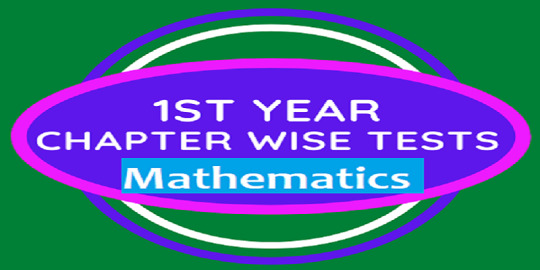
View On WordPress
#ba 1st year political science 1st semester unit-1#ba 1st year political science chapter -1#class 11 chapter 1 maths#class 11 maths chapter 1#class 12 maths chapter 1#engineering mathematics#fourier series | engineering mathematics#icse class 10 maths chapter 1#inter class mathematics chapter 1#mathematics#ncert class 11 maths chapter 1#statistics class 11 maths full chapter#what are the chapters in maths class 11th
1 note
·
View note
Note
psychic damage counteracted with you explaining in the tags ty ❤️
if the one thing my degree is ever useful for is shielding my tumblrinas from the horrors then it will all have been worth it ❤️❤️❤️
#i hated learning about fourier series i did a terrible problem sheet on it in second year#it’s one of those topics where i appreciate it more from a distance#inbox#mucamaca
1 note
·
View note
Text
I have an awful sinus headache and a whole bunch of homework that is definitely not helping the headache (relative motion is not my friend) but I’ve got an update post on how fluff/whumptober is going that’ll be up later today! I’m the meantime, I have to be enough of a functional adult to the go to the grocery store and cook dinner
#yes this is just me complaining#my sinuses ache like a bitch#and I have so much homework and I don’t want to do any of it#Fourier series? absolutely disgusting#manometers? ew men#relative motion? fuck that shit#it’s not even that much#I’m just whiny
1 note
·
View note
Text
Number Tournament: ZERO vs THE IMAGINARY UNIT (The Championship Match)


[link to all polls]
0 (zero; naught)
seed: 4 (60 nominations)
previous opponent: negative one
class: additive identity
biography: one of the most revolutionary numbers in all of mathematics, and not just because of its rotund symbol.
the notion of "nothingness" as a number in and of itself rather than merely as a placeholder was discovered independently in many parts of the world at many different times, particularly in cultures that used forms of positional notation (ie. writing numbers in a way where every symbol has some numerical value, and its position within a number indicates that the value is multiplied by some power of a "base", often ten). due to its strange nature as a number with no value, many properties that are often taken for granted with other numbers do not apply to zero.
in the Number Tournament, zero has beaten some incredibly iconic numbers seemingly effortlessly. fifteen, thirty-six, sixty-four, the golden ratio, and negative one were all no match for naught. it is truly a force to be reckoned with.
zero is a number associated with emptiness, with the void, as well as with new beginnings. it is one of the foundations of all of mathematics, and it is certainly one of the best numbers.
[Wikipedia article]
i
seed: 11 (46 nominations)
previous opponent: NaN
class: imaginary
biography: another groundbreaking number, discovered much more recently than zero. much like zero, in its earliest uses i (the imaginary unit) was considered more of placeholder than a number in its own right, as the name "imaginary number" might suggest.
the imaginary numbers (and the complex numbers they are a part of) were born as an elegant solution to a practical problem, and they've persisted as a tool for modeling things in the physical world, no less real than the "real numbers". complex numbers are useful for "translating" statements about shapes into statements about numbers, and vice versa. they are crucial to the Fourier transform, which itself is a vital part of signal processing and many areas of physics.
in the Number Tournament, i faced off against a series of increasingly tougher challengers: forty-seven, twenty-seven, e, two, and Not a Number, each race closer than the last. i fought hard to get here, and we're all very proud of it for making it this far.
i is associated with the mathematical tradition of taking "you can't do that" as a challenge, and with thinking outside of the box. it is a fundamental component of our modern understanding of the world, and it is certainly one of the best numbers.
[Wikipedia article]
4K notes
·
View notes
Text
Music Theory notes (for science bitches) part 3: what if. there were more notes. what if they were friends.
Hello again, welcome back to this series where I try and teach myself music from first principles! I've been making lots of progress on zhonghu in the meantime, but a lot of it is mechanical/technical stuff about like... how you hold the instrument, recognising pitches
In the first part I broke down the basic ideas of tonal music and ways you might go about tuning it in the 12-tone system, particularly its 'equal temperament' variant [12TET]. The second part was a brief survey of the scales and tuning systems used in a selection of music systems around the world, from klezmer to gamelan - many of them compatible with 12TET, but not all.
So, as we said in the first article, a scale might be your 'palette' - the set of notes you use to build music. But a palette is not a picture. And hell, in painting, colour implies structure: relationships of value, saturation, hue, texture and so on which create contrast and therefore meaning.
So let's start trying to understand how notes can sit side by side and create meaning - sequentially in time, or simultaneously as chords! But there are still many foundations to lay. Still, I have a go at composing something at the end of this post! Something very basic, but something.
Anatomy of a chord
I discussed this very briefly in the first post, but a chord is when you play two or more notes at the same time. A lot of types of tonal musical will create a progression of chords over the course of a song, either on a single instrument or by harmonising multiple instruments in an ensemble. Since any or all of the individual notes in a chord can change, there's an enormous variety of possible ways to go from one chord to another.

But we're getting ahead of ourselves. First of all I wanna take a look at what a chord actually is. Look, pretty picture! Read on to see what it means ;)
So here is a C Minor chord, consisting of C, D# and G, played by a simulated string quartet:
(In this post there's gonna be sound clips. These are generated using Ableton, but nothing I talk about should be specific to any one DAW [Digital Audio Workstation]. Ardour appears to be the most popular open source DAW, though I've not used it. Audacity is an excellent open source audio editor.)

Above, I've plotted the frequency spectrum of this chord (the Fourier transform) calculated by Audacity. The volume is in decibels, which is a logarithmic scale of energy in a wave. So this is essentially a linear-log plot.
OK, hard to tell what's going on in there right? The left three tall spikes are the fundamental frequencies of C4 (262Hz), D♯4 (310Hz), and G4 (393Hz). Then, we have a series of overtones of each note, layered on top of each other. It's obviously hard to tell which overtone 'belongs to' which note. Some of the voices may in fact share overtones! But we can look at the spectra of the indivudal notes to compare. Here's the C4 on its own. (Oddly, Ableton considered this a C3, not a C4. as far as I can tell the usual convention is that C4 is 261.626Hz, so I think C4 is 'correct'.)
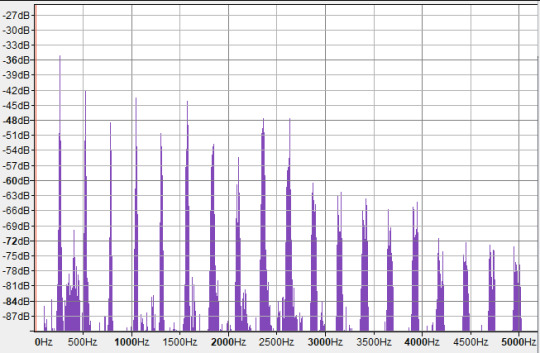
Here, the strongest peaks are all at integer multiples of the fundamental frequency, so they look evenly spaced in linear frequency-space. These are not all C. The first overtone is an octave above (C5), then we have three times the frequency of C4 - which means it's 1.5 times the frequency of C5, i.e. a perfect fifth above it! This makes it a G. So our first two overtones are in fact the octave and the fifth (plus an octave). Then we get another C (C6), then in the next octave we have frequencies pretty close to E6, G6 and A♯6 - respectively, intervals of a major third, a perfect fifth, and minor 7th relative to the root (modulo octaves).
However, there are also some weaker peaks. Notably, in between the first and second octave is a cluster of peaks around 397-404Hz, which is close to G4 - another perfect fifth! However, it's much much weaker than the overtones we discussed previously.
The extra frequencies and phase relationships give the timbre of the note, its particular sound - in this case you could say the sense of 'softness' in the sound compared to, for example, a sine wave, or a perfect triangle wave which would also have harmonics at all integer frequencies.
Perhaps in seeing all these overtones, we can get an intuitive impression of why chords sound 'consonant'. If the frequencies of a given note are already present in the overtones, they will reinforce each other, and (in extremely vague and unscientific terms) the brain gets really tickled by things happening in sync. However, it's not nearly that simple. Even in this case, we can see that frequencies do not have to be present in the overtone spectrum to create a pleasing sense of consonance.
Incidentally, this may help explain why we consider two notes whose frequencies differ by a factor of 2 to be 'equivalent'. The lower note contains all of the frequencies of the higher note as overtones, plus a bunch of extra 'inbetween' frequencies. e.g. if I have a note with fundamental frequency f, and a note with frequency 2f, then f's overtones are 2f, 3f, 4f, 5f, 6f... while 2f's overtones are 2f, 4f, 6f, 8f. There's so much overlap! So if I play a C, you're also hearing a little bit of the next C up from that, the G above that, the C above that and so on.
For comparison, if we have a note with frequency 3f, i.e. going up by a perfect fifth from the second note, the frequencies we get are 3f, 6f, 9f, 12f. Still fully contained in the overtones of the first note, but not quite as many hits.
Of course, the difference between each of these spectra is the amplitudes. The spectrum of the lower octave may contain the frequencies of the higher octave, but much quieter than when we play that note, and falling off in a different way.
(Note that a difference of ten decibels is very large: it's a logarithmic scale, so 10 decibels means 10 times the energy. A straight line in this linear-log plot indicates a power-law relationship between frequency and energy, similar to the inverse-square relationship of a triangle wave, where the first overtone has a quarter of the power, the second has a ninth of the power, and so on.)
So, here is the frequency spectrum of the single C note overlaid onto the spectrum of the C minor chord:

Some of the overtones of C line up with the overtones of the other notes (the D# and G), but a great many do not. Each note is contributing a bunch of new overtones to the pile. Still, because all these frequencies relate back to the base note, they feel 'related' - we are drawn to interpret the sounds together as a group rather than individually.
Our ears and aural system respond to these frequencies at a speed faster than thought. With a little effort, you can pick out individual voices in a layered composition - but we don't usually pick up on individual overtones, rather the texture created by all of them together.
I'm not gonna take the Fourier analysis much further, but I wanted to have a look at what happens when you crack open a chord and poke around inside.
However...
In Western music theory terms, we don't really think about all these different frequency spikes, just the fundamental notes. (The rest provides timbre). We give chords names based on the notes of the voices that comprise them. Chord notation can get... quite complicated; there are also multiple ways to write a given chord, so you have a degree of choice, especially once you factor in octave equivalence! Here's a rapid-fire video breakdown:
youtube
Because you have all these different notes interacting with each other, you further get multiple interactions of consonance and dissonance happening simultaneously. This means there's a huge amount of nuance. To repeat my rough working model, we can speak of chords being 'stable' (meaning they contain mostly 'consonant' relations like fifths and thirds) or 'unstable' (featuring 'dissonant' relations like semitones or tritones), with the latter setting up 'tension' and the former resolving it.
However, that's so far from being useful. To get a bit closer to composing music, it would likely help to go a bit deeper, build up more foundations and so on.
In this post and subsequent ones, I'm going to be taking things a little slower, trying to understand a bit more explicitly how chords are deployed.
An apology to Western music notation
In my first post in this series, I was a bit dismissive of 'goofy' Western music notation. What I was missing is that the purpose of Western music notation is not to clearly show the mathematical relationships between notes (something that's useful for learning!)... but to act as a reference to use while performing music. So it's optimising for two things: compactness, and legibility of musical constructs like phrasing. Pedagogy is secondary.
Youtuber Tantacrul, lead developer of the MuseScore software, recently made a video running over a brief history of music notation and various proposed alternative notation schemes - some reasonable, others very goofy. Having seen his arguments, he makes a pretty good case for why the current notation system is actually a reasonable compromise... for representing tonal music on the 12TET system, which is what it's designed for.

So with that in mind, let me try and give a better explanation of the why of Western music notation.
In contrast to 'piano roll' style notation where you represent every possible note in an absolute way, here each line of the stave (staff if you're American) represents a scale degree of a diatonic scale. The key signature locates you in a particular scale, and all the notes that aren't on that scale are omitted for compactness (since space is at an absolute premium when you have to turn pages during a performance!). If you're doing something funky and including a note outside the scale, well that's a special case and you give it a special-case symbol.
It's a similar principle to file compression: if things are as-expected, you omit them. If things are surprising, you have to put something there.
However, unlike the 简谱 jiǎnpǔ system which I've been learning in my erhu lessons, it's not a free-floating system which can attach to any scale. Instead, with a given clef, each line and space of the stave has one of three possible notes it could represent. This works, because - as we'll discuss momentarily - the diatonic scales can all be related to each other by shifting certain scale degrees up or down in semitones. So by indicating which scale degrees need to be shifted, you can lock in to any diatonic scale. Naisuu.
This approach, which lightly links positions to specific notes, keeps things reasonably simple for performers to remember. In theory, the system of key signatures helps keep things organised, without requiring significant thought while performing.
That is why have to arbitrarily pick a certain scale to be the 'default'; in this case, history has chosen C major/A minor. From that point, we can construct the rest of the diatonic scales as key signatures using a cute mathematical construct called the 'circle of fifths'.
How key signatures work (that damn circle)
So, let's say you have a diatonic major scale. In piano roll style notation, this looks like (taking C as our base note)...

And on the big sheet of scales, like this:

Now, let's write another diatonic major scale, a fifth up from the first. This is called transposition. For example, we could transpose from C major to G major.

Thanks to octave equivalency, we can wrap these notes back into the same octave as our original scale. (In other words, we've added 7 semitones to every note in our original scale, and then taken each one modulo 12 semitones.) Here, I duplicate the pattern down an octave.

Now, if we look at what notes we have in both scales, over the range of the original major scale.

Well, they're almost exactly the same... but the fourth note (scale degree) is shifted up by one semitone.
In fact, we've seen this set of notes before - it is after all nothing more than a cyclic permutation of the major scale. We've landed on the 'Lydian mode', one of the seven 'modes' of the diatonic major scale we discussed in previous posts. We've just found out that the Lydian mode has the same notes as a major scale starting a fifth higher. In general, whether we think of it as a 'mode' or as a 'different major scale' is a matter of where we start (the base note). I'm going to have more to say about modes in a little bit.
With this trick in mind, we produce a series of major scales starting a fifth higher each time. It just so happens that, since the fifth is 7 semitones, which is coprime with the 12 semitones of 12TET, this procedure will lead us through every single possible starting note in 12TET (up to octave equivalency).
So, each time we go up a fifth, we add a sharp on the fourth degree of the previous scale. This means that every single major scale in 12TET can be identified by a unique set of sharps. Once you have gone up 12 fifths, you end up with the original set of notes.
This leads us to a cute diagram called the "circle of fifths".

Because going up a fifth is octave-equivalent to going down a fourth, we can also look back one step on the circle to find out which note needs to be made sharper. So, from C major to G major, we have to sharpen F - the previous note on the circle from C. From G major to D major, we have to sharpen C. From D major to A major, we have to sharpen G. And so on.
By convention, when we write a key signature to define the particular scale we're using, we write the sharps out in circle-of-fifths order like this. The point of this is to make it easy to tell at a glance what scale you're in... assuming you know the scales already, anyway. This is another place where the aim of the notation scheme is for a compact representation for performers rather than something that makes the logical structure evident to beginners.
Also by convention, key signatures don't include the other octaves of each note. So if F is sharp in your key signature, then every F is sharp, not just the one we've written on the stave.
This makes it less noisy, but it does mean you don't have a convenient visual reminder that the other Fs are also sharp. We could imagine an alternative approach where we include the sharps for every visible note, e.g. if we duplicate every sharp down an octave for C♯ major...

...but maybe it's evident why this would probably be more confusing than helpful!
So, our procedure returns the major scales in order of increasing sharps. Eventually you have added seven sharps, meaning every scale degree of the original starting scale (in this case, C Major) is sharpened.
What would it mean to keep going past this point? Let's hop in after F♯ Major, at the bottom of the Circle of Fifths; next you would go to C♯ Major by sharpening B. So far so good. At this point we have sharps everywhere, so the notes in your scale go...
C♯ D♯ E♯ F♯ G♯ A♯ B♯ C♯
...except that E♯ is the same as F, and B♯ is the same as C, so we could write that as
C♯ D♯ F F♯ G♯ A♯ C C♯
But then to get to 'G♯ Major', you would need to sharpen... F♯? That's not on the original C-major scale we started with ! You could say, well, essentially this adds up to two sharps on F, so it's like F♯♯, taking you to G. So now you have...
G♯ A♯ C C♯ D♯ F G G♯
...and the line of the stave that you would normally use for F now represents a G. You could carry on in this way, eventually landing all the way back at the original set of notes in C Major (bold showing the note that just got sharpened in each case):
D♯ F G G♯ A♯ C D D♯
A♯ C D D♯ F G A A♯
F G A A♯ C D E F
C D E F G A B C
But that sounds super confusing - how would you even represent the double sharps on the key signature? It would break the convention that each line of the stave can only represent three possible notes. Luckily there's a way out. We can work backwards, going around the circle the other way and flattening notes. This will hit the exact same scales in the opposite order, but we think of their relation to the 'base' scale differently.
So, let's try starting with the major scale and going down a fifth. We could reason about this algebraically to work out that sharpening the fourth while you go up means flattening the seventh when you go down... but I can also just put another animation. I like animations.

So: you flatten the seventh scale degree in order to go down a fifth in major scales. By iterating this process, we can go back around the circle of fifths. For whatever reason, going down this way we use flats instead of sharps in the names of the scale. So instead of A♯ major we call it B♭ major. Same notes in the same order, but we think of it as down a rung from F major.
In terms of modes, this shows that the major scale a fifth down from a given root note has the same set of notes as the "mixolydian mode" on the original root note. ...don't worry, you don't gotta memorise this, there is not a test! Rather, the point of mentioning these modes is to underline that whether you're in a major key, minor key, or one of the various other modes is all relative to the note you start on. We'll see in a moment a way to think about modes other than 'cyclic permutation'.
Let's try the same trick on the minor key.

Looks like this time, to go up we need to sharpen the sixth degree, and to go down we need to flatten the second degree. As algebra demands, this gives us the exact same sequence of sharps and flats as the sequence of major scales we derived above. After all, every major scale has a 'relative minor' which can be achieved by cyclically permuting its notes.
Going up a fifth shares the same notes with the 'Dorian mode' of the original base note, and going down a fifth shares the same notes with the 'Phrygian mode'.
Here's a summary of movement around the circle of fifths. The black background indicates the root note of the new scale.

Another angle on modes
In my first two articles, I discussed the modes of the diatonic scale. Leaping straight for the mathematically simplest definition (hi Kolmogorov), I defined the seven 'church modes' as simply being cyclic permutations of the intervals of the major scale. Which they are... but I'm told that's not really how musicians think of them.
Let's grab the chart of modes again. (Here's the link to the spreadsheet).

We can get to these modes by cyclically permuting the others, but we can also get to them by making a small adjustment of one to a few particular scale degrees. When you listen to a piece of music, you're not really doing cyclic permutations - you're building up a feeling for the pattern of notes based on your lifelong experience of hearing music that's composed in this system. So the modes will feel something like 'major until, owo what's this, the seventh is not where I thought it would be'.
Since the majority of music is composed using major and minor modes, it's useful therefore to look at the 'deltas' relative to these particular modes.
To begin with, what's the difference between major and minor? To go from major to natural minor, you shift the third, sixth and seventh scale degrees down by one semitone.

So those are our two starting points. For the others, I'm going to be consulting the most reliable music theory source (some guy on youtube) to give suggestions of the emotional connotations these can bring. The Greek names are not important, but I am trying to build a toolbox of elements here, so we can try our hand at composition. So!
The "Dorian mode" is like the natural minor, but the sixth is back up a semitone. It's described as a versatile mode which can be mysterious, heroic or playful. I guess that kinda makes sense, it's like in between the major and minor?

The "Phrygian mode" is natural minor but you also lower the 2nd - basically put everything as low as you can go within the diatonic modes. It is described as bestowing an ominous, threatening feeling.

The "Lydian mode" is like the major scale, but you shift the fourth up a semitone, landing on the infamous tritone. It is described as... uh well actually the guy doesn't really give a nice soundbitey description of what this mode sounds like, besides 'the brighest' of the seven, this video's kinda more generally about composition, whatever. But generally it's pretty big and upbeat I think.

The "Mixolydian" mode is the major, but with the seventh down a semitone. So it's like... a teeny little bit minor. It's described as goofy and lighthearted.

We've already covered the Aeolian/Natural Minor, so that leaves only the "Locrian". This one's kinda the opposite of the Lydian: just about everything in the major scale is flattened a bit. Even from the minor it flattens two things, and gives you lots of dissonance. This one is described as stereotypically spooky, but not necessarily. "One of the least useful", oof.

Having run along the catalogue, we may notice something interesting. In each case, we always either only sharpen notes, or only flatten notes relative to the major and minor scales. All those little lines are parallel.
Indeed, it turns out that each scale degree has one of two positions it can occupy. We can sort the diatonic modes according to whether those degrees are in the 'sharp' or 'flat' position.

This is I believe the 'brightness' mentioned above, and I suppose it's sort of like 'majorness'. So perhaps we can think of modes as sliding gradually from the ultra-minor to the infra-major? I need to experiment and find out.
What have we learned...?
Scale degrees are a big deal! The focus of all this has been looking at how different collections of notes relate to each other. We sort our notes into little sets and sequences, and we compare the sets by looking at 'equivalent' positions in some other set.
Which actually leads really naturally into the subject of chord progressions.
So, musical structure. A piece of tonal music as a whole has a "palette" which is the scale - but within that, specific sections of that piece of music will pick a smaller subset of the scale, or something related to the scale, to harmonise.
The way this goes is typically like this: you have some instruments that are playing chords, which gives the overall sort of harmonic 'context', and you have a single-voiced melody or lead line, which stands out from the rest, often with more complex rhythms. This latter part is typically what you would hum or sing if you're asked 'how a song goes'. Within that melody, the notes at any given point are chosen to harmonise with the chords being played at the same time.
The way this is often notated is to write the melody line on the stave, and to write the names of chords above the stave. This may indicate that another hand or another instrument should play those chords - or it may just be an indication for someone analysing the piece which chord is providing the notes for a given section.
So, you typically have a sequence of chords for a piece of music. This is known as a chord progression. There are various analytical tools for cracking open chord progressions, and while I can't hope to carry out a full survey, let me see if I can at least figure out my basic waypoints.
Firstly, there are the chords constructed directly from scales - the 'triad' chords, on top of which can be piled yet more bonus intervals like sevenths and ninths. Starting from a scale, and taking any given scale degree as the root note, you can construct a chord by taking every other subsequent note.
So, the major scale interval pattern goes 2 2 1 2 2 2 1. We can add these up two at a time, starting from each position, to get the chords. For each scale degree we therefore get the following intervals relative to the base note of the chord...
I. 0 4 7 - major
ii. 0 3 7 - minor
iii. 0 3 7 - minor
IV. 0 4 7 - major
V. 0 4 7 - major
vi. 0 3 7 - minor
viiᵒ. 0 3 6 - diminished
Now hold on a minute, where'd those fuckin Roman numerals come from? I mentioned this briefly in the first post, but this is Roman numeral analysis, which is used to talk about chord progressions in a scale-independent way.
Here, a capital Roman numeral represents a major triad; a lowercase Roman numeral represents a minor triad; a superscript 'o' represents a dimished triad (minor but you lower the fifth down to the tritone); a superscript '+' represents an augmented triad (major but you boost the fifth up to the major sixth).
So while regular chord notation starts with the pitch of the base note, the Roman numeral notation starts with a scale degree. This way you can recognise the 'same' chord progression in songs that are in quite different keys.
OK, let's do the same for the minor scale... 2 1 2 2 1 2 2. Again, adding them up two at a time...
i. 0 3 7 - minor
iiᵒ. 0 3 6 - diminished
III. 0 4 7 - major
iv. 0 3 7 - minor
v. 0 3 4 - minor
VI. 0 4 7 - major
VII. 0 4 7 - major
Would you look at that, it's a cyclic permutation of the major scale. Shocker.
So, both scales have three major chords, three minor chords and a diminished chord in them. The significance of each of these positions will have to be left to another day though.
What does it mean to progress?
So, you play a chord, and then you play another chord. One or more of the voices in the chord change. Repeat. That's all a chord progression is.
You can think of a chord progression as three (or more) melodies played as once. Only, there is an ambiguity here.
Let's say, idk, I threw together this series of chords, it ended up sounding like it would be something you'd hear in an old JRPG dungeon, though maybe that's just 'cos it's midi lmao...
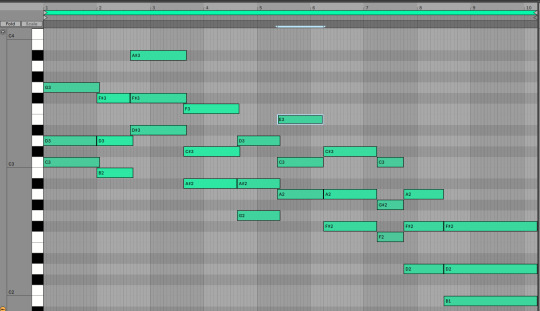
I emphasise at this point that I have no idea what I'm doing, I'm just pushing notes around until they sound good to me. Maybe I would know how to make them sound better if I knew more music theory! But also at some point you gotta stop theorising and try writing music.
So this chord progression ended up consisting of...
Csus2 - Bm - D♯m - A♯m - Gm - Am - F♯m - Fm - D - Bm
Or, sorted into alphabetical order, I used...
Am, A♯m, Bm, Csus2, D, D♯m, Fm, F♯m, Gm
Is that too many minor chords? idk! Should all of these technically be counted as part of the 'progression' instead of transitional bits that don't count? I also dk! Maybe I'll find out soon.
I did not even try to stick to a scale on this, and accordingly I'm hitting just about every semitone at some point lmao. Since I end on a B minor chord, we might guess that the key ought to be B minor? In that case, we can consult the circle of fifths and determine that F and C would be sharp. This gives the following chords:
Bm, C♯dim, D, Em, F♯m, G, A
As an additional check, the notes in the scale:
B, C♯, D, E, F, G♯, A
Well, uh. I used. Some of those? Would it sound better if I stuck to the 'scale-derived' chords? Know the rules before you break them and all that. Well, we can try it actually. I can map each chord in the original to the corresponding chord in B minor.
This version definitely sounds 'cleaner', but it's also... less tense I feel like. The more dissonant choices in the first one made it 'spicier'. Still, it's interesting to hear the comparison! Maybe I could reintroduce the suspended chord and some other stuff and get a bit of 'best of both worlds'? But honestly I'm pretty happy with the first version. I suppose the real question would be which one would be easier to fit a lead over...
Anyway, for the sake of argument, suppose you wanted to divide this into three melodies. One way to do it would be to slice it into low, central and high parts. These would respectively go...
Since these chords mostly move around in parallel, they all have roughly the same shape. But equally you could pick out three totally different pathways through this. You could have a part that just jumps to the nearest note it can (until the end where there wasn't an obvious place to go so I decided to dive)...
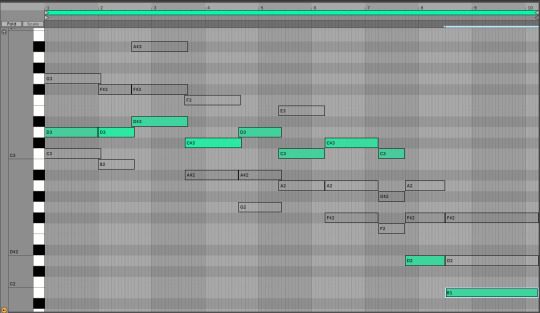
Those successive relationships between notes also exist in this track. Indeed, when two successive chords share a note, it's a whole thing (read: it gets mentioned sometimes in music theory videos). You could draw all sorts of crazy lines through the notes here if you wanted.
Nevertheless, the effects of movements between chords come in part from these relationships between successive notes. This can give the feeling of chords going 'up' or 'down', depending on which parts go up and which parts go down.
I think at this point this post is long enough that trying to get into the nitty gritty of what possible movements can exist between chords would be a bit of a step too far, and also I'm yawning a lot but I want to get the post out the door, so I let's wrap things up here. Next time: we'll continue our chord research and try and figure out how to use that Roman numeral notation. Like, taking a particular Roman numeral chord progression and see what we can build with it.
Hope this has been interesting! I'm super grateful for the warm reception the last two articles got, and while I'm getting much further from the islands of 'stuff I can speak about with confidence', fingers crossed the process of learning is also interesting...
62 notes
·
View notes
Text
Fourier never appeared in the main series, but man, he's actually really funny. Absolutely like Subaru in his behavior but less cringe that stems from realism and second-hand embarrassment. Just friends being friends
Since I got my hands on that EX novel, I'm gonna pitch some moments of him so he's at least remembered if his name is brought up. I'll include some pictures for reference, and won't include the whole thing to avoid spoilers
1. This one can be found on the wiki as is: he fell in love with Crusch at first sight, but the moment she saw him, she threatened him with a knife in his own house—she then proceeded to almost attempt suicide for her mistake


2. He's so much like Subaru. He's loud, brash, in love with a girl at first sight, has small worries that he blows out of proportion unless they're absolutely important and life-changing like impending death, falls to his knees in anime-style sulking when told he's not as manly/strong as he wants to be to the girl he likes...
3. After seeing Crusch, you see how there's a guy chasing him in the first picture? That's his tutor. Fourier proceeded to slap him in the face ("MY EYE!!" screamed in comical fashion), drag him down a hall, and make him hit his head on every column and wall in existence
4. In the second picture, where Crusch holds a dagger, Fourier backtracks over it a lot like Subaru would
Fourier: Who would give their daughter a dagger on their birthday? They've no sense.
Crusch: Your Highness, I asked for this dagger from my father as a gift that day.
Fourier: Yep! Your father's the most sensible man ever! Daggers, wonderful gifts to young girls, they are!
5. That illustration of him and Crusch in a sword fight? He did that so Crusch would wear a dress.

Crusch sees him about to fall over like a shaking fawn, pathetic with trembling legs and supporting himself on his sword. He's exhausted and wanting to pass out or cry, and Crusch is like "Should we stop?"
And Fourier is all "NO!" and charges in with war cries the entire time.
"YAAAAAHHHH! CRUUUSCH! WEAR A DRESSS!!!"
I crap not, that's all he shouted, and it kinda scared Crusch.
"Wear makeup! Like flowers! Wear jewelry! Show me that beautiful smileeee!!! Uwaaaaaa!!!"
That's his motivation. It's hilarious and also sad, because he knows he probably hurt Crusch a lot for not letting her wear dresses. He's so exhausted by the end of it that he literally passes out on the ground after Crusch cedes it's her defeat
6. He didn't know Ferris was a boy. So when he had Ferris pose as his fiancee after Crusch couldn't so he could turn down his marriage prospect,
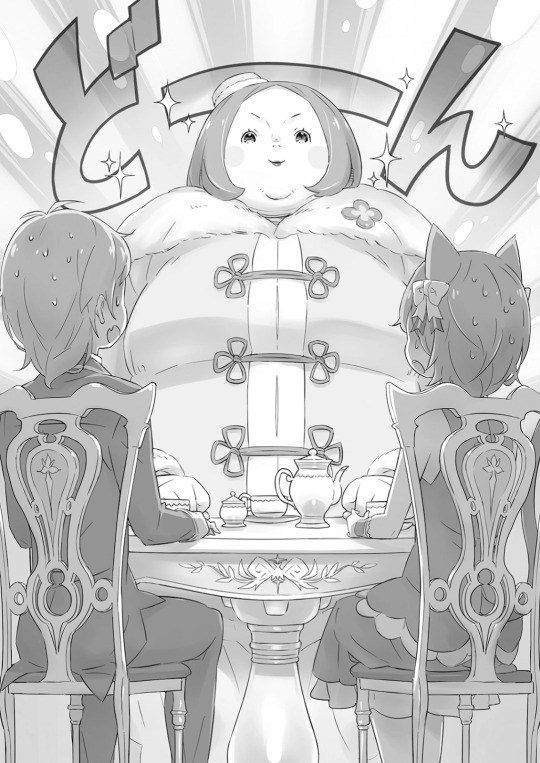
He did so, thinking Ferris was a girl. He only found out afterwards.
Also, before they actually went through with the plan, Fourier was raring to pretend being Crusch's lover, and getting all flustered at the idea. Imagine servant Subaru being all blushy over going on a date with Emilia and wiggling around. Not very different
"M-Me... and Crusch..!!"
"Compose yourself, my prince!"
- Fourier and Ferris, off of memory
7. The castle rumored that Fourier was gay, because he declared he loved Ferris, no matter his gender.
"As long as you're you..!"
Which is really sweet (how Fourier loves him). Still, Ferris worried he hated him after the reveal.
Ferris and Crusch are discussing this new rumor as Ferris is afraid of confronting Fourier after he learned he was a male... then His Highness comes barreling in, basically screaming and crying
"Crusch! Ferris! It's horrible, oh so horrible! I need you two now through the worst struggle of my life! Where are my two trusted people?!"
Because he literally just heard the rumor himself.
I think he was afraid that Crusch wouldn't love him if she thought he was batting for the other team, and that's why he stressed over the rumor? He also feared Crusch not liking him if he got fat
He's so fricken funny and this is just from me skimming the book. I haven't sat down to read it through, but just by skimming, Fourier and Subaru behave so similarly that it's just- my gosh.
Do Ferris and Crusch look at Subaru and think of the prince? When Subaru shouted and disrupted the Royal Selection gathering, and Julius probably saw Joshua, did those two see Fourier?
Granted, Fourier is more wise and composed than Subaru, and probably would've been more graceful about his interruptions, but the shouting of what he wants and thinks when riled up? The "wisdom" (knowledge) that comes out of nowhere, which both Fourier and Subaru have? (Fourier from instinct, Subaru from Return By Death)
Fourier wanted so badly to let Crusch be a woman, and fawned over her beauty and just wanted her to enjoy typical things of women. Subaru kicks his blanket like it's personally assaulting him, just thinking of multiple Emilias as he tries to sleep, and isn't afraid of showing his affection throughout the entire series
On the point of affection, neither of them are afraid of showing it to people they care about. Subaru braids hair, plays with kids, compliments outfits and smiles, Fourier hugs and tells his dreams of futures with his friends and has dances with them, etc.
(They even have the penchant of acting like things are fine to Julius by not telling him anything before they literally collapse in front of him [Fourier in a carriage, Subaru being possessed], leaving Julius to deal with them when things go south)
(On that note, it's sweet that Julius always calls for Ferris when someone is hurting, because he knows who can help best)
Anyway, Fourier? Funny kid. Resembles Subaru. Parallels can probably be drawn from them. Is important to the development of Crusch and Ferris, so it's not bad to remember him. The history of the royal family should come into play when regarding the Archbishop of Lust and Felt, too.
#spoilers#fourier lugunica#a fun kid#has the potential for a lot of analysis#crusch karsten#ferris argyle#felix argyle#ferris#rezero#re:zero#re zero#EX Novel 1#(i think)#before Subaru's arrival#minor character to the main story but a major one to the ex novel#not much else for me to add on to that i can think of#julius juukulius#images#since i skimmed it i might be wrong that subaru and fourier are similar#but i still think parallels can be drawn. like RBD and the intuition of the royal family#maybe felt has that? she chose tonchinkan for their talent?#unsure i cant remember why she took them in#natsuki subaru#lugunica#royal family#ex novel#anyway
66 notes
·
View notes
Text


Oct. 21, 2023
yesterday was a struggle - getting out of bed, focusing, staying put. i went outside to our garden to study bc i was getting agitated being in my room. it wasn't helpful at all with my family coming to talk to me every 10 mins 😭
one thing i'm tryino implement in my life now is listening to my body -which my brain is also a part of! so if i get uneasy or agitated or sleepy, i take a break. if i still can't focus after the break, i just take the rest of the day off and reset for tomorrow.
☀️ things i did
reviewed fourier series expansion of a trigonometric function
made notes for my position paper, a final project for one of my minor courses
had a meeting with my groupmates to sort out our financial statements for this mockbusiness pitching project
when i'm done writing my paper, i would like to talk about it.
#solarstudies#studyblr#engineering studyblr#stemblr#studyspo#study aesthetic#chemical engineering#study blog#engineering#study motivation#university#studying#stem academia#women in stem
20 notes
·
View notes
Text



On December 17th 1907 William Thomson, Lord Kelvin died.
Kelvin was outstanding in theory as well as practice. His nephew died at sea and caused him to work for safety at sea; his compass was adopted worldwide; his tide gauge was in use for many years. He provided solutions for the laying of the first transatlantic telegraph cables. A system of temperature and make of refrigerator are named after him.
Although born in Northern Ireland, at 21-25 College Square East in Belfast in 1824, William Thomson spent most of his life in Scotland after his father became Professor of Mathematics at Glasgow University. Kelvin attended university classes from the age of 10. He wrote his first scientific paper, under the pseudonym 'PQR', aged only 16.
In his teens he learned French well enough to read the work of eminent French mathematician Jean Baptiste Joseph Fourier. Philip Kelland, Professor of Mathematics at Edinburgh University, had criticised Fourier's work on the theory of heat. Kelvin boldly stated that Kelland was wrong – and later scientists agreed with him.
From 1841 to 1845 Kelvin attended Cambridge University. He was an excellent student – although he shocked his father by spending his allowance on a boat, so it was not all work for the young scholar!
After graduating, Kelvin worked in a Paris laboratory with physics professor Victor Regnault.
Kelvin was influenced by the mathematical ideas of George Green, a self-taught miller's son from Nottingham.
He later brought an essay of Green's to the attention of fellow mathematicians and physicists by republishing it in a respected scientific journal. Until then the essay on mathematical analysis, electricity and magnetism had gone largely unnoticed.
In 1846, aged only 22, Kelvin returned to Glasgow to become Professor of Natural Philosophy. He remained in this post for 53 years. Keen to see students involved in practical experiment, he established what became the first university physics laboratory.
Kelvin continued to study the nature of heat. He realised that it would be useful to be able to define extremely low temperatures precisely. In 1848, he proposed an absolute temperature scale, now called 'the Kelvin scale'.
After further research, he formulated the second law of thermodynamics. This states that heat will not flow from a colder to a hotter body.
His interest in the transmission of electricity prompted his appointment as Director of the Atlantic Telegraph Company in 1856. The company was to install a telegraph cable under the Atlantic Ocean. Atlantic Cable Expeditions in 1857, 1858 and 1865 failed, but communication by cable finally succeeded in 1866.
From 1870 onwards, Kelvin spent many summers on his yacht 'Lalla Rookh', and invented several marine instruments to improve navigation and safety. He introduced a mariner's compass more accurate than any other in existence, and a machine to predict tide levels worldwide.
In 1884 Kelvin travelled to the United States to give a series of lectures. These were enthusiastically received, and were published in 1904 as the 'Baltimore Lectures'. He became a Lord in 1892 and took the name Kelvin because of his Glasgow connections. By the time of his death in 1907, he was an international celebrity, widely respected and honoured.
12 notes
·
View notes